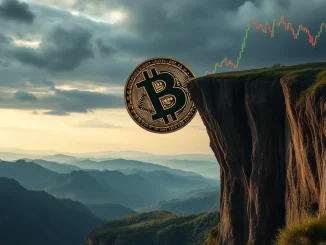
Are you feeling a sense of calm in the crypto market lately? Bitcoin (BTC), the king of cryptocurrencies, has been exhibiting unusually low volatility, leading to a surge in Bitcoin traders’ risk aversion. But is this tranquility here to stay? According to a recent crypto market analysis from K33 Research, the answer might be a resounding no. Let’s dive into what’s happening and what it means for you.
Bitcoin Traders and Growing Risk Aversion: What’s the Vibe?
Imagine a scenario where the usual rollercoaster of the Bitcoin market slows to a gentle, predictable ride. That’s pretty much where we are now. Vetle Lunde, a sharp analyst at K33 Research, points out that Bitcoin traders are increasingly showing risk aversion. This isn’t necessarily a bad thing, but it’s a significant shift from the often wild and unpredictable nature of crypto markets. Think of it like this: traders are pulling back, playing it safe, and maybe even holding their breath a little, waiting to see what happens next.
But what exactly does this risk aversion look like in numbers? Lunde highlights a few key indicators:
- Trading Volume Plunge: The excitement around Bitcoin trading has cooled off significantly. Volumes have retreated to levels seen before the U.S. presidential election in November of last year. It’s like the buzz has worn off, and people are taking a breather.
- Returns Tapering Off: The days of massive, quick gains seem to have taken a pause. Returns on Bitcoin are less dramatic, suggesting a more cautious market.
- Options Premiums Decline: Even in the derivatives market, the heat has subsided. Options premiums, which often reflect market speculation and volatility expectations, have also decreased.
- ETF Flows Normalize: Remember the hype around Bitcoin ETFs? While still relevant, the intense flows into these investment vehicles have also returned to a more normal pace.
Essentially, across the board, the metrics suggest a market that’s taking a step back, becoming more conservative, and less driven by speculative frenzy.
Low Volatility: Is This Calm Before the Storm in the Crypto Market?
One of the most striking aspects of the current market is the dramatically reduced volatility of Bitcoin. Volatility, the degree of price fluctuation, is often considered a defining characteristic of the crypto space. However, recently, Bitcoin volatility has plummeted to its lowest levels in months.
Think of volatility as the market’s heartbeat. A high heartbeat means rapid, dramatic price swings – exciting, but potentially risky. A low heartbeat, like we’re seeing now, suggests stability, but also perhaps a lull before a more significant move. Lunde believes this period of low volatility is unlikely to be sustained. He argues that the very risk aversion we’re seeing is a sign that traders are anticipating – and preparing for – a potential surge in downside volatility.
Here’s a simplified breakdown of why low volatility might be temporary:
| Factor | Explanation | Implication for Volatility |
|---|---|---|
| Market Uncertainty | High uncertainty often precedes periods of significant market movement. Traders are unsure of the next major catalyst, leading to cautious positioning. | Increased potential for volatility as uncertainty resolves. |
| Compressed Volatility Periods | Historically, periods of low volatility in Bitcoin have often been followed by periods of high volatility. Markets tend to oscillate between these states. | Statistical likelihood of a volatility spike increases after prolonged low volatility. |
| Trader Positioning (Risk Aversion) | While risk aversion itself can dampen short-term volatility, it also suggests pent-up energy in the market. When direction becomes clearer, this energy can fuel a significant move. | Risk aversion can be a precursor to a larger market reaction once a trend emerges. |
So, while the current calm might be comforting, it’s crucial to remember that in the world of crypto, periods of low volatility are often just the prelude to more dynamic market conditions.
Deep Dive Crypto Market Analysis: Unpacking the Trader Sentiment
To truly understand what’s going on, we need to delve deeper into this crypto market analysis and unpack the trader sentiment. Why are Bitcoin traders exhibiting such pronounced risk aversion? Several factors could be at play:
- Macroeconomic Uncertainty: The global economic landscape remains uncertain. Inflation worries, interest rate hikes, and geopolitical tensions can all contribute to a cautious market mood.
- Regulatory Scrutiny: The ever-present specter of regulation continues to loom over the crypto industry. Uncertainty about future regulations can make traders hesitant to take on significant risk.
- Market Saturation/Fatigue: After periods of intense bull runs and hype cycles, markets can experience periods of consolidation and fatigue. Traders might be taking profits, reassessing strategies, and waiting for new catalysts.
- Lack of Clear Direction: As Lunde points out, we are in a period without a clear market direction. This ambiguity naturally leads to caution and risk aversion as traders avoid making bold bets without a strong conviction.
Essentially, it’s a mix of external economic factors, internal crypto-specific uncertainties, and the natural ebb and flow of market cycles that are contributing to the current risk-averse sentiment among Bitcoin traders.
Bitcoin ETF Flows and Trading Volume: Back to Pre-Election Norms
Lunde’s observation that Bitcoin ETF flows and trading volume have returned to pre-U.S. presidential election levels is particularly telling. The period leading up to and immediately following the election saw heightened activity and speculation in the crypto markets. The return to pre-election norms suggests a significant cooling-off period.
Consider these points regarding ETF flows and trading volume:
- ETF Flows as Sentiment Indicator: Bitcoin ETF flows are often seen as a barometer of institutional and mainstream investor sentiment towards Bitcoin. Normalized flows suggest a less exuberant, more measured approach from these investor segments.
- Trading Volume and Market Interest: Lower trading volumes typically indicate reduced overall market participation and interest. While not necessarily negative, it reflects a decrease in the urgency and excitement that often drives market rallies.
- Pre-Election Comparison: Comparing current levels to pre-election periods provides a useful benchmark. It highlights the extent to which the market has moved away from the heightened activity of that time.
This normalization in ETF flows and trading volume reinforces the broader picture of a market that is currently in a phase of consolidation and reduced speculative fervor.
Navigating Uncertainty: Actionable Insights for BTC Traders
So, what should Bitcoin traders do in this environment of heightened risk aversion and low volatility? Lunde’s advice is clear and pragmatic: “This is a time of high uncertainty, so we recommend waiting until a clear direction is revealed.”
Here are some actionable insights for navigating this uncertain period:
- Exercise Patience: The market is signaling caution, and it’s wise to heed that signal. Avoid impulsive trading decisions driven by short-term noise.
- Monitor Market Signals: Keep a close eye on key indicators like volatility, trading volume, ETF flows, and macroeconomic developments. Look for signs of a shift in market direction.
- Manage Risk Prudently: Ensure your portfolio is appropriately sized for your risk tolerance. Avoid over-leveraging, especially in times of uncertainty. Lunde notes that leverage levels are currently medium, reducing the immediate risk of mass liquidations, but caution is still warranted.
- Develop a Plan, But Stay Flexible: Have a trading plan in place, but be prepared to adapt as market conditions evolve. Rigidity can be detrimental in a dynamic market like crypto.
- Educate Yourself: Use this period to deepen your understanding of market analysis, risk management, and the factors that drive crypto prices. Knowledge is your best tool in navigating uncertainty.
Conclusion: Bracing for Change in the Bitcoin Landscape
The current phase of low volatility and increased Bitcoin traders’ risk aversion is unlikely to be a long-term state. Crypto market analysis suggests that this calm is more of a pause than a permanent condition. While the reduced volatility might be a welcome respite from the usual market turbulence, it’s essential to remain vigilant and prepared for potential shifts.
As Vetle Lunde wisely advises, patience and observation are key in this uncertain environment. Waiting for a clearer market direction, managing risk carefully, and staying informed are the most prudent strategies for Bitcoin traders right now. The crypto market is known for its dynamic nature, and periods of calm often precede periods of significant change. Are you ready for what comes next?



